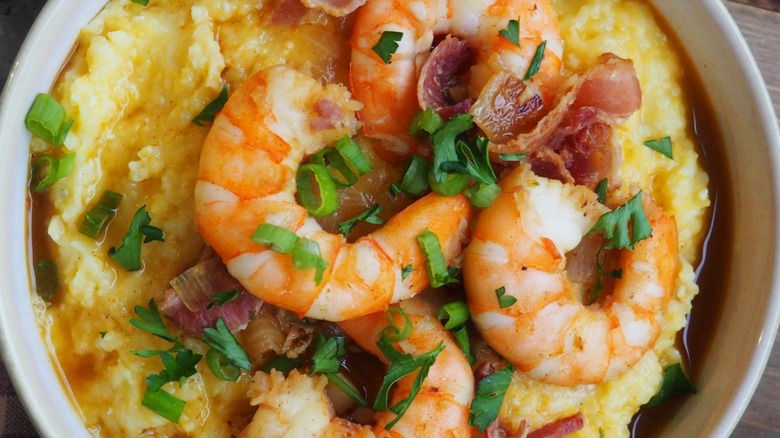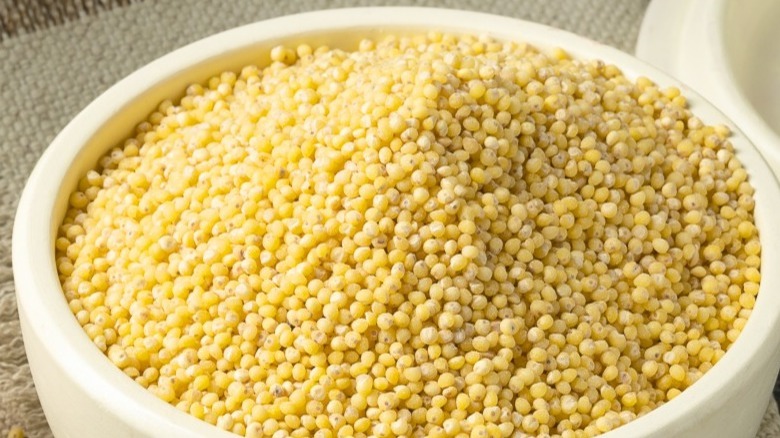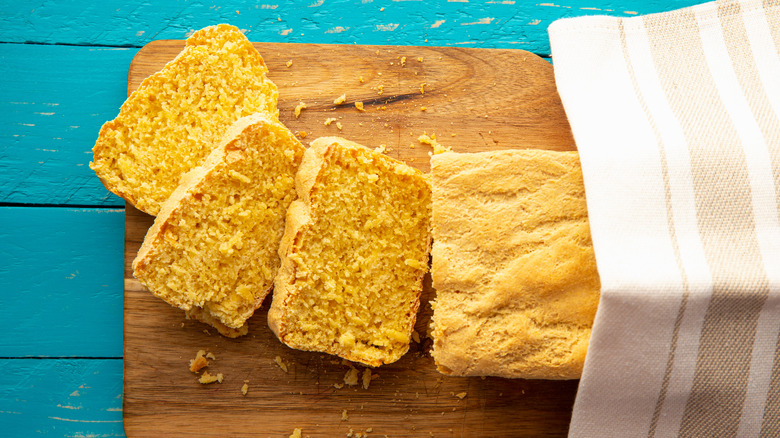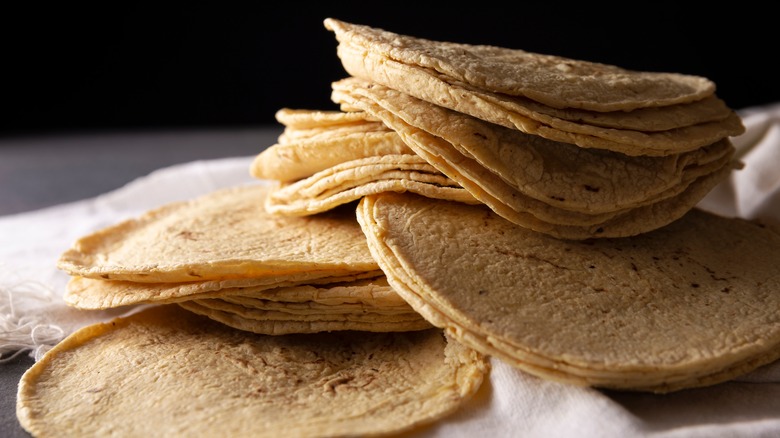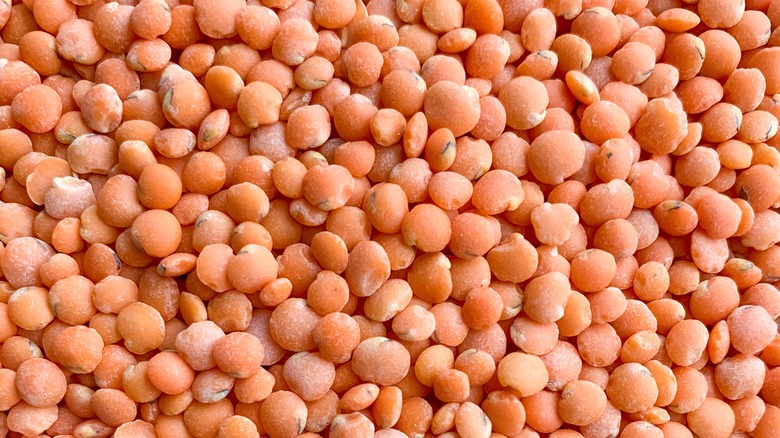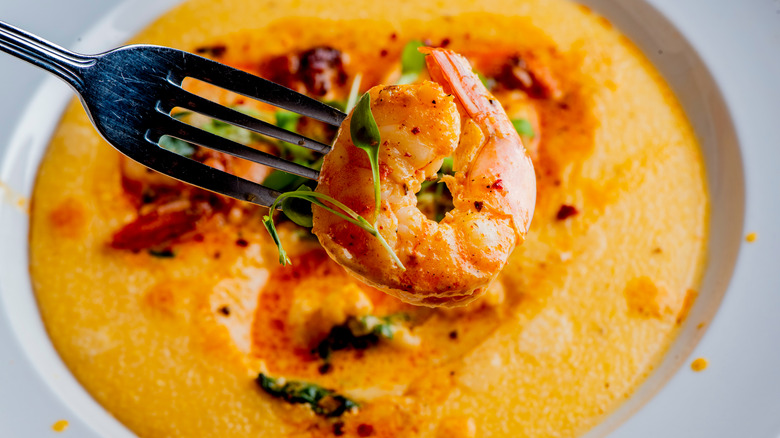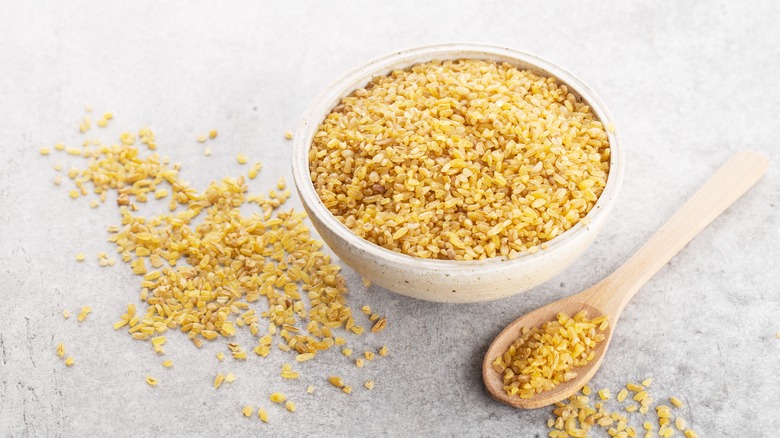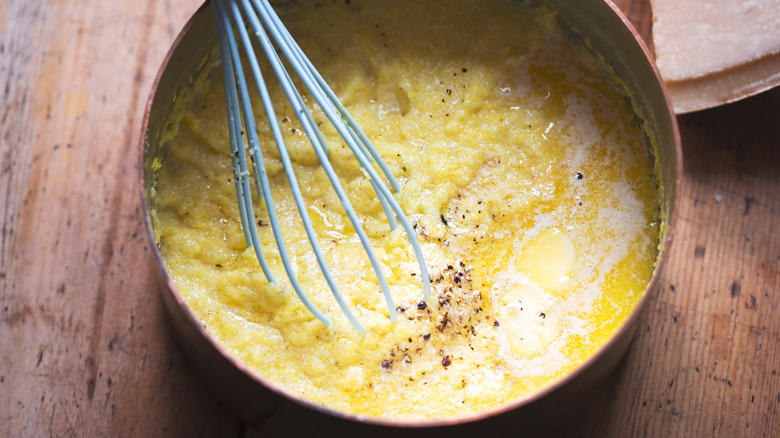12 Facts You Should Know About Southern Grits
In every part of the world, there are foods that remind you of home. From clam chowder and lobster rolls in Boston to fish tacos in southern California, these foods thoroughly and almost stereotypically represent where they come from. Grits is one of these foods.
Grits is deeply ingrained in both the history and imagery of the South. However, grits was largely not known outside the South until 1985, when Chef Bill Neal wrote a recipe for cheese grits and shrimp, which was published in The New York Times. Following this, chefs became more willing to use the Southern staple as a palate for new creations and new flavor combinations, particularly among those exhausted by polenta (via The Local Palate).
In recent years, grits has become "upscale," regularly appearing on gourmet menus with modern variations (via Chicago Tribune). However, grits is both simple and deeply complicated, reflecting a dish born of humble roots that has become a beloved staple with a passionate following. It is also misunderstood, both because of marketing and intentional attempts to confuse grits with other products and because of a lack of understanding about grits and its history.
1. Grits and polenta are different
Depending on where you live, you may run into a bag of "Grits and Polenta" in your supermarket. Due to the marketing of certain brands and the now-corrected musings of a former Food Network personality, there is the misconception that polenta and grits are basically the same. They are not.
Polenta is Latin for crushed and hulled barley and, per Merriam-Webster, is related to pollen, the Latin word for fine flour. Traditionally made with flint corn, polenta can be made with buckwheat flour, barley meal, yellow corn meal, or any mixture containing thereof. Grits, on the other hand, is almost always made with dent corn. Dent corn is a high-starch type of maize, named because of the dip or "dent" on the top of the corn kernel (via SFGate). According to Bon Appetit, the difference in corn primarily affects the dishes' textures: polenta is chewier, while grits are smooth and creamy.
Another difference between polenta and grits is that the corn used for grits is usually, but not always, nixtamalized (via The Congaree Milling Company). Nixtamalization is the application of an alkali, like limewater, to corn. This makes the niacin in the corn kernel bioavailable, making the treated corn more nutritious. It partially breaks down the kernel's hull, making the corn easier to grind, and removes almost all the mycotoxins the corn may have. This process also kills the germ, making the kernels safe to store long-term without the possibility of sprouting (via Mexicanist). Finally, per Cooks Illustrated, the alkali softens the starch, reducing the needed cooking time by a third or more. While polenta can take up to 3 hours to cook, grits take no more than 45 minutes.
2. Not all Southerners eat their grits the same way
A good way to pick a fight with Southerners is to discuss how best to eat their grits. Different regions in the South eat grits differently.
It is incorrect to think of Southern cuisine as a monolith. Different regions have different opinions on food, and opinions about the right way to eat grits vary throughout the South. While the commonly accepted style of eating grits served with butter is the simplest, it is not unheard of to see grits served with white sugar, brown sugar, honey, molasses, maple syrup, gravy, or cheese. Grits are usually served as breakfast food but can be a part of any meal. Shrimps and grits, for example, is an anytime dish hailing from South Carolina (via The Old Mill). It is not uncommon to serve stews and chilis on a bed of grits, and grits can be allowed to cool and then cut and fried, like polenta.
Grits is a romanticized part of Southern life. Three states have recognized grits through legislation. In 2010, Georgia named grits its official prepared food (via Justia). In Oklahoma, grits is part of the official state meal (via the Oklahoma Gazette). South Carolina is the only state that requires grits to be enriched the same way flour is. It is illegal to sell grits not labeled as "enriched" in the state (via CaseText).
3. Grits are not originally from the South
While grits are linked to the Antebellum South, that's not where, or when, they originated. Grits are part of a global tradition of corn porridges. While corn is a New World crop (via Encyclopedia Britannica), it is easy to dry, making it suitable for long-distance travel and trade. Be it in South Africa, Italy, or the American South, corn porridge is an efficient way to feed large groups with very cheap food.
Grits was originally a Native American dish. Grits was created by the Muscogee tribe, whose ancestral lands covered almost all of Alabama, and parts of Tennessee, Georgia, and Florida (via Deep South). The Muscogee taught corn cultivation methods to the early European settlers and explained how to use nixtamalization to make the corn safe from toxic fungi and molds (per Southern Foodways Alliance). They also taught the settlers their recipes for corn, including Johnny cakes and grits.
The name "grits" came from the British, who called coarse cornmeal "grist." Erin Byers Murray, a food writer and the author of "Grits: A Cultural and Culinary Journey Through The South," speculates that grits or some variation of the dish has existed since 8,700 BC, when the first evidence of milled corn in Central America was found (via NPR).
4. Grits are perfect for baking
Grits, when it comes right down to it, is cornmeal. According to Substitute Food, grits can be swapped for yellow cornmeal in recipes, including in baking, though it will create a different, more coarse texture in cakes and baked goods. Also, because grits have a different moisture absorption rate than non-nixtamalized cornmeal (as explained by the Journal of Texture Studies), grits can be used in higher moisture recipes, such as steam-leavened breads and puddings, without falling apart.
Grits is gluten-free, making it an appealing substitute for those with food allergies. As grits is nixtamalized, it binds and forms doughs more easily than non-nixtamalized cornmeal (via Breadtopia). This makes grits suitable for bread recipes. Grits can also be used to add bulk to a recipe, such as in chilis and soups.
Flavor-wise, the type of corn used in the grits has a direct affect on the recipe. Hominy grits will lend a sweet flavor to the final recipe (per Food Network), while yellow corn will lend a more pronounced corn flavor.
5. Grits have a Mexican connection
While grits is regularly compared to polenta, the two dishes are not that close. They are typically made of different types of corn and grits and polenta are prepared differently. Grits is usually cooked with milk or water, although broths or stocks can be used. Polenta is typically made with a broth or light stock, such as chicken. Grits is more akin to South Africa's mielliepap (also called pap), a water-based stiff corn porridge (via MyRecipes).
In fact, grits is more closely related to tortillas than to polenta. Grits is compositionally similar to masa harina, which is used to make tortillas (via Allrecipes). Both are made from the same corn and both are nixtamalized — the difference between the two is that masa harina is ground into a fine flour. In theory, grits can be used as a substitute to masa harina (via The Food Guys). To do this, you should find non-quick or traditional grits (it is sometimes sold as "old-fashioned"). The grits will need to be ground in a food processor until it is slightly coarser than white flour. The substitute masa harina can be used one for one in recipes for real masa harina.
6. Grits and rice both rule in the South
In the South, rice is king. With most of the nation's rice farms being in the South, the South is a principal consumer of the starchy staple in this country (via the U.S. Department of Agriculture). Despite this, grits is a strong contender for second place. As a corn-based food, grits is part of a group that is second in the United States only to wheat in regards to availability (via the U.S. Department of Agriculture). Grits can be substituted for rice in almost any dish, lending a different character and flavor compared to the sometimes-bland rice.
Broken rice, strangely enough, can be cooked into a dish that resembles grits. Rice grits, also known as shorts or brokens, is a by-product of rice milling. When cooked, they take on a creamy texture, almost like risotto (per Bon Appetit).
Quaker Oats estimates that three-quarters of its grits produced in the U.S. are sold in Southern states including Florida, Georgia, and South Carolina (via The Star).
7. Grits is known as hominy in South Carolina
Grits is sacred in South Carolina. The spiritual home of the dish, South Carolina's attitude toward grits is unique in many ways. For example, cooked grits is called "hominy" in South Carolina (per The Local Palate). While grits is made from hominy corn, in the rest of the US, "hominy" refers to the whole hominy corn kernels. Cooked hominy kernels can be found in canned vegetable sections in supermarkets, or frozen, and are regularly used in casseroles, soups, stews, or eaten as it is.
Grits is an ingrained part of South Carolina life. In fact, there is a resolution by the state legislature declaring grits to be the key to world peace. In the 1999 declaration making grits South Carolina's official food, the state declared that grits is "an inexpensive, simple, and thoroughly digestible food, [grits] should be made popular throughout the world. Given enough of it, the inhabitants of planet Earth would have nothing to fight about. A man full of [grits] is a man of peace," (via South Carolina General Assembly).
8. There's more than just instant grits
Most supermarket grits are known as "quick grits." These "5-minutes grits" are ground fine, making it easy for them to cook quickly. Another common supermarket variety are instant grits where the hominy kernels are either boiled or steamed, dried, and then ground fine (via Charleston Culinary Tours). As the grits are precooked, many argue that the taste of instant grits is bland or washed out.
As almost all mass market grits also have their hulls and germ removed, the only difference between "quick grits" and "old-fashioned" grits is the size of the grind and the resulting cooking time. While grits were traditionally ground using a stone mill, stone milled grits are now rare. Grits are commonly now ground using a steel roller mill (per Fast Company). But there are other types of grits available.
Stone mill grits can be found mostly in gift shops and the Internet. These grits come without the hull or whole-ground (also called speckled). Speckled grits usually have black grains in the mix, coming from the ground-up hull and pin — the kernels' connection to the cob — that is left on the hominy kernel.
Different mills have experimented with different corn varieties to create unique grits blends. As reported by Discover South Carolina, some of the stand-outs are Sea Island Blue (a deep indigo grits made from Heirloom Sea Island corn), Unicorn (a rosy pink grits from Geechie Boy Mill), Guinea Flint (pumpkin colored grits made from orange corn kernels), and Jimmy Red (a yellow and white grits mix with red flecks).
9. Grits has a connection to slavery
Grits is made of just a couple of easily obtained ingredients and is filling, making it a staple of diets where money needs to be stretched. There is no wonder why grits was embraced in a region where poverty is a way of life for most (via U.S. Department of Agriculture).
The history of one of the most well known modern recipe for grits reflects one of the darkest periods of America. Grits was developed by Southern slaves, particularly slaves in South Carolina. Cornmeal was a regular part of slaves' diets, so cornmeal recipes — including corn dumplings, corn fritters, corn bread, and grits — were regularly seen in slave kitchens. Coupled with shrimp — which slaves could easily fish out of the streams and rivers bordering plantations without slaveowners noticing — and one of South Carolina's most iconic dishes, shrimp and grits, was born (via The Local Palate). The dish would eventually, like most slave dishes, make it to the slaveowner's kitchens and become ingrained into the Southern diet.
To this day many African-American families still eat grits. Grits is a comfort food that can entice feelings of home and family. It is a link to a shared history that goes back for centuries and even millennia.
10. Grits has become elevated poor food
Grits is a traditional "poverty food." As corn became a commodity crop in the South and elsewhere in the United States, grits suffered as it was commercially mass produced without much consideration of the end product's taste or quality. But this mass production helped further transform grits into "fuel in a box" — a high energy food that could be had for pennies per serving (via Tennessee State Museum).
Fortunately, there has been a reversal and a new attention toward quality, flavor, and variation has launched a "Grits Renaissance." Like lobster and oysters, grits is a food that was once relegated to poorer populations. However, with the advent of artisan grinds and grits being served in fancier restaurants, grits have been elevated beyond its humble roots. Grits is linked not to a specific people or to a specific gender, but to the South itself.
The story of grits is the story of appropriation, according to food anthropologist Erin Byers Murray, from its adoption and renaming by British colonists to its transition from slave kitchens to its current move to high-scale restaurant menus. It is also the story of a shared heritage. "You can talk about artisanal producers and the evolution of shrimp and grits in fine dining, but when you get down to it, it's about the memory of someone — maybe your mom or your grandma or your uncle — standing at a stove and stirring," Byers Murray told NPR. "It's the definition of slow food."
11. Grits can be healthy ... well, healthy-ish
It is difficult to argue that a cereal is truly healthy. The defining characteristic of cereals — starch — is what typically makes them disastrous to diets. Grits tend to be higher in starch than most other cereals due to the fact that grits is made of dent corn, a high starch variety of corn. Despite this, grits is, unadorned, low in calories and high in B vitamins — including niacin, thiamin, riboflavin, and folate. Grits is also low in sugar, making it relatively safe for those on diabetic diets (via EatingWell). Grits is also high in lutein and zeaxanthin, making grits valuable for its contributions to eye health (via Bakerpedia).
Grits is not as healthy, though, as the "superfood" cereals, like oats and quinoa. Grits is low in fiber and protein and has less iron than its cousins. Also, when coupled with its traditional pairings — like butter, cheese, or heavy cream — grits' calorie content can suddenly swell. However, grits can also be paired with healthier options, like fruits, vegetables, and healthy fats to make grits a nutritious and delicious option (via EatingWell).
12. There is more than one way to cook grits
Grits is unique in the sense that it can be cooked in multiple ways. Grits does not have a significant amount of gluten, so stirring while cooking is not as important for starch formation as it is to avoid scorching. So, in theory, applications that do not require high heat (or stirring) can be used to cook grits.
One technique, as advocated by the artisan grits miller Anson Mills, is to soak a cup of grits in 2 ½ cups of water overnight. Then, cooking the grits in its soaking water over medium heat, add 2 cups of boiling water to the grits slowly, a ladle at a time, while consistently stirring the grits to prevent sticking and burning. This method cuts the cooking time in half (via Discover South Carolina).
Another, promoted by celebrity chef Nathalie Dupree, is to mix 1 part grits with 4 parts water in a glass bowl and microwave in five minutes pulses, adding water when needed, and cooking until the grits are tender (via Discover South Carolina).
